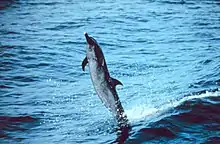
This is a list of the mammal species recorded in Tuvalu. There are three mammal species in Tuvalu identified in the IUCN Red List, all of which are marine mammals of the order Cetacea: ginkgo-toothed beaked whale (Mesoplodon ginkgodens), pygmy killer whale (Feresa attenuata), and pantropical spotted dolphin (Stenella attenuata).[1]
The literature review by Miller (2006) found four additional cetaceans reported: orca or killer whale (Orcinus orca), spinner dolphin (Stenella longirostris), bottlenose dolphin (Tursiops truncatus), and sperm whale (Physeter macrocephalus).[2][3] The pantropical spotted dolphin (Stenella attenuata) is found in the lists of both Miller and the IUCN.
A revision of the list of cetaceans reported in the ocean surrounding Tuvalu was carried out by Miller (2009),[4] who listed a "minke-like" whale (Balaenoptera species) and a diminutive sperm whale (Kogia species).[4]
In 2010 a research voyage was conducted within the exclusive economic zones (EEZs) of Kiribati and Tuvalu. The survey confirmed the presence of seven species of cetaceans: sperm whale, killer whale, Bryde's whale (Balaenoptera brydei), short-finned pilot whale (Globicephala macrorhynchus), false killer whale (Pseudorca crassidens), spinner dolphin, and striped dolphin (Stenella coeruleoalba).[5]
The Pacific Ocean surrounding Tuvalu is within the range of these cetaceans although sightings of some of these species may be infrequent.
The following tags are used to highlight each species' conservation status as assessed by the International Union for Conservation of Nature:
| DD | Data deficient | There is inadequate information to make an assessment of the risks to this species. |
Order: Cetacea (whales)
.jpg.webp)
The order Cetacea includes whales, dolphins and porpoises. They are the mammals most fully adapted to aquatic life with a spindle-shaped nearly hairless body, protected by a thick layer of blubber, and forelimbs and tail modified to provide propulsion underwater.
- Parvorder Mysticeti: baleen whales
- Superfamily Balaenopteroidea
- Family Balaenopteridae: rorquals
- Subfamily Balaenopterinae
- Genus Balaenoptera: slender rorquals
- Bryde's whale, Balaenoptera brydei[5] DD
- Genus Balaenoptera: slender rorquals
- Subfamily Balaenopterinae
- Family Balaenopteridae: rorquals
- Superfamily Balaenopteroidea
- Parvorder Odontoceti: toothed whales
- Superfamily Delphinoidea: dolphins and relatives
- Family Delphinidae: oceanic dolphins
- Subfamily Delphininae
- Genus Stenella
- Pantropical spotted dolphin, Stenella attenuata LR/cd
- Spinner dolphin, Stenella longirostris[5] LR/cd
- Striped dolphin, Stenella coeruleoalba[5] LC
- Genus Tursiops
- Common bottlenose dolphin, Tursiops truncatus DD
- Genus Stenella
- Subfamily Orcininae
- Genus Feresa
- Pygmy killer whale, Feresa attenuata DD
- Genus Globicephala
- Short-finned pilot whale, Globicephala macrorhyncus[5] LR/cd
- Genus Orcinus
- Killer whale (orca), Orcinus orca DD
- Genus: Pseudorca
- False killer whale, Pseudorca crassidens[5] DD
- Genus Feresa
- Subfamily Delphininae
- Family Delphinidae: oceanic dolphins
- Superfamily Physeteroidea, sperm whales
- Family Kogiidae
- Genus Kogia
- Dwarf sperm whale, Kogia sima LR/lc
- Genus Kogia
- Family Physeteridae: sperm whale family
- Genus Physeter
- Sperm whale, Physeter macrocephalus [5] VU
- Genus Physeter
- Family Kogiidae
- Superfamily Ziphioidea, beaked whales
- Family Ziphidae, beaked whales
- Subfamily Hyperoodontinae
- Genus Mesoplodon, mesoplodont whales
- Ginkgo-toothed beaked whale, Mesoplodon ginkgodens DD
- Genus Mesoplodon, mesoplodont whales
- Subfamily Hyperoodontinae
- Family Ziphidae, beaked whales
- Superfamily Delphinoidea: dolphins and relatives
See also
Notes
- ↑ This list is derived from the IUCN Red List which lists species of mammals and includes those mammals that have recently been classified as extinct (since 1500 AD). The taxonomy and naming of the individual species is based on those used in existing Wikipedia articles as of 21 May 2007 and supplemented by the common names and taxonomy from the IUCN, Smithsonian Institution, or University of Michigan where no Wikipedia article was available.
- ↑ Miller, Cara (14 February 2006). Current State of Knowledge of Cetacean Threats, Diversity and Habitats in the Pacific Islands Region. WDCS Australasia Inc. p. 98.
- ↑ "Secretariat of the Pacific Regional Environment Programme (SPREP)" (PDF). Pacific Islands Regional Species Programme 2008-2012. 2008. Retrieved 9 October 2013.
- 1 2 Miller, Cara (1 July 2009). Current State of Knowledge of Cetacean Threats, Diversity and Habitats in the Pacific Islands Region (PDF). WDCS Australasia Inc. pp. 49–50.
- 1 2 3 4 5 6 7 Murase, H & Temoai, I & Kirata, Taratau & Finkaso, S & Yasunaga, Genta & Pastene, L.A. (2023). "A note on cetaceans off Kiribati and Tuvalu from a research cruise in October 2010". Journal of Cetacean Research and Management. 13 (2): 153–158. doi:10.47536/jcrm.v13i2.544. S2CID 256717782.
{{cite journal}}: CS1 maint: multiple names: authors list (link)
References
- Murase, H & Temoai, I & Kirata, Taratau & Finkaso, S & Yasunaga, Genta & Pastene, L.A. (2023). "A note on cetaceans off Kiribati and Tuvalu from a research cruise in October 2010". Journal of Cetacean Research and Management. 13 (2): 153–158. doi:10.47536/jcrm.v13i2.544. S2CID 256717782.
{{cite journal}}: CS1 maint: multiple names: authors list (link) - "Tuvalu - Summary of species on the 2008 IUCN Red List" (PDF). IUCN. 2008. Retrieved 4 November 2011.
- "Mammal Species of the World". Smithsonian National Museum of Natural History. 2005. Archived from the original on 27 April 2007. Retrieved 22 May 2007.
- "Animal Diversity Web". University of Michigan Museum of Zoology. 1995–2006. Retrieved 22 May 2007.
- Edgar Waite published an account of The Mammals, Reptiles, and Fishes of Funafuti (Australian Museum, Sydney, 1897).[1]
- ↑ Waite, Edgar R. (1897). "The mammals, reptiles, and fishes of Funafuti". Australian Museum Memoir. Australian Museum Memoir 3(3): 165–202. 3 (3): 165–202. doi:10.3853/j.0067-1967.3.1897.494.

